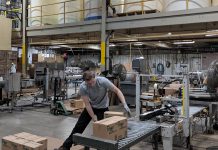The high-speed rail network between Quebec City and Toronto — which includes a stop in Peterborough — is another step closer to reality.
On Wednesday (February 19), Prime Minister Justin Trudeau announced the consortium that has been selected to develop the project and confirmed $3.9 billion in federal funding for the project over six years.
Described as the largest transportation infrastructure project in Canada since the construction of the St. Lawrence Seaway over 60 years ago, the proposed high-speed rail network will extend over nearly 1,000 kilometres of dedicated and electrified tracks, with stops in Quebec City, Trois-Rivières, Laval, Montreal, Ottawa, Peterborough, and Toronto.
Once operational, the fully electric trains running on the network will reach speeds of up to 300 km/hour, cutting current travel times in half. A trip between Montréal to Toronto will take three hours.
The consortium selected for the project, called Cadence, is an alliance of Canadian and international private partners including CPDQ Infra, AtkinsRéalis, SYSTRA Canada, Keolis Canada, Air Canada, and SNCF Voyageurs.
Cadence will co-develop the project with Alto, formerly known as VIA HFR, which is a Crown corporation formed in 2022 to oversee the high-speed rail project. Alto, which means “high” in Italian, will also be the official name of the high-speed rail service. Alto and Cadence will be signing a contract setting out the terms of the co-development phase of the project.
“I’m firmly convinced that the way a project is developed is as crucial as the project itself,” says Alto president and CEO Martin Imbeau in a media release. “Which is why we are developing it now, in collaboration with Cadence and relying on the best practices of the industry.”
“We have assembled a unique group of talents, combining the know-how of a federal Crown corporation with the experience of a consortium of world-class private partners. Together, we will build a project that will surpass the highest expectations of Canadians.”
According to a media release, the high-speed rail network will boost GDP by up to $35 billion annually and create more than 51,000 jobs during construction. Electrified high-speed rail will also help Canada reduce its carbon dioxide emissions and meet its climate target by giving travellers an efficient and reliable alternative to driving their own cars.
“When I close my eyes and I see myself in 2040 and 2050, I just can’t imagine seeing millions more cars on congested costly highways,” Imbeau said when he visited Peterborough in November 2023 to speak at the annual Mayor’s Breakfast at the Peterborough Golf Country and Club. “We need to act now for the future generations. We need to develop a transportation service that Canadians will pick over driving that is the smarter, more eco-friendly choice.”
The Peterborough and Kawarthas Chamber of Commerce has welcomed the announcement that high-speed rail is moving ahead with service to Peterborough.
“Ensuring Peterborough is a stop on the high-speed rail line has been a priority of the chamber, as this is a key way to connect our community to the rest of the province,” says the chamber’s interim president and CEO Gail Moorhouse in a media release. “This rail line will serve an area with 18 million people with an economy worth more than $850 billion.”
Former chamber president and CEO Stuart Harrison, a long-time advocate of bringing passenger rail service back to Peterborough, was involved in the non-profit Shining Waters Railway corporation, which produced a 2011 study that inspired VIA Rail’s initial plan to build a new high-frequency rail line from Quebec City to Toronto.
Since then, the chamber has been working with VIA Rail, VIA HFR, and now Alto to develop the business case for the rail line.
“Having Peterborough as a major stop on this rail project is a win for the tireless advocacy work of the chamber,” says Joel Wiebe, the chamber’s vice president of government relations and operations.
“While a project of this scale is not built overnight, now is the time for us to invest in making the most of this once in a generation opportunity,” adds Moorhouse. “This is a huge opportunity for our community and our businesses, increasing market access, tourism, and better connecting Peterborough to Canada’s economic centres.”
With files from Paul Rellinger.



























